Virtual reality (VR) has emerged as a promising tool in the field of mental health. Central to this technology are immersive environments, which enable exposure to highly controlled virtual experiences that feel real. In this Review, we elaborate on the active elements of immersive experiences and how VR-based treatments work. We provide an overview of developments in the use of VR to treat mental health conditions (anxiety, psychotic symptoms, post-traumatic stress, eating disorders, depression and stress management) with a focus on the core mechanisms that drive effective interventions. Artificial intelligence, biofeedback and gamification are emerging areas of development, and we discuss how they might enhance the accessibility, engagement and effectiveness of psychological treatments. Conducting rigorous studies with user-centred designs in diverse populations is a key research priority. As the use of VR in mental health continues to evolve, addressing ethical and implementation considerations is critical for ensuring ongoing treatment improvements.
This is a preview of subscription content, access via your institution
Access options
Subscribe to this journal
Receive 12 digital issues and online access to articles
only 5,51 € per issue
Buy this article
- Purchase on SpringerLink
- Instant access to full article PDF
Prices may be subject to local taxes which are calculated during checkout
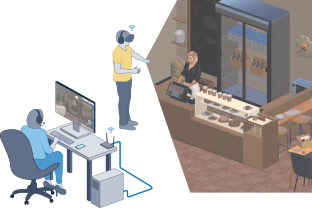
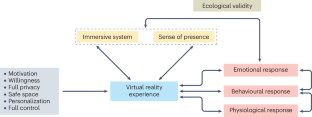
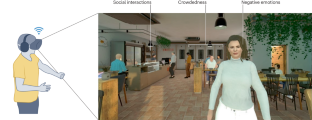
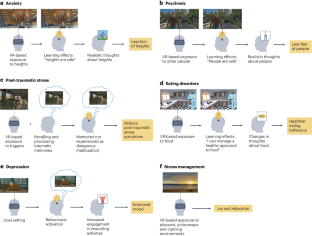
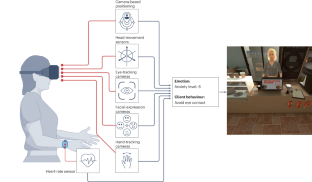
Similar content being viewed by others
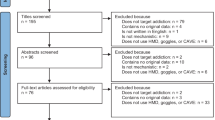
Virtual reality: a powerful technology to provide novel insight into treatment mechanisms of addiction
Article Open access 06 December 2021
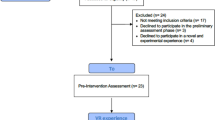
Customized virtual reality naturalistic scenarios promoting engagement and relaxation in patients with cognitive impairment: a proof-of-concept mixed-methods study
Article Open access 22 November 2023

Effects and safety of virtual reality-based mindfulness in patients with psychosis: a randomized controlled pilot study
Article Open access 13 September 2023
References
- Bell, I. et al. Digital technology for addressing cognitive impairment in recent-onset psychosis: a perspective. Schizophr. Res. Cogn.28, 100247 (2022). ArticlePubMedPubMed CentralGoogle Scholar
- Valmaggia, L. The use of virtual reality in psychosis research and treatment. World Psychiatry16, 246–247 (2017). ArticlePubMedPubMed CentralGoogle Scholar
- Slater, M. & Sanchez-Vives, M. V. Enhancing our lives with immersive virtual reality. Front. Robot. AI3, https://doi.org/10.3389/frobt.2016.00074 (2016).
- Freeman, D. et al. Virtual reality in the assessment, understanding, and treatment of mental health disorders. Psychol. Med.47, 2393–2400 (2017). ArticlePubMedPubMed CentralGoogle Scholar
- World Health Organization. The WHO Special Initiative for Mental Health (2019-2023): Universal Health Coverage for Mental Health (WHO, 2019).
- Bell, I. H., Nicholas, J., Alvarez-Jimenez, M., Thompson, A. & Valmaggia, L. Virtual reality as a clinical tool in mental health research and practice. Dialogues Clin. Neurosci.22, 169–177 (2020). ArticlePubMedPubMed CentralGoogle Scholar
- Torous, J. et al. The growing field of digital psychiatry: current evidence and the future of apps, social media, chatbots, and virtual reality. World Psychiatry20, 318–335 (2021). ArticlePubMedPubMed CentralGoogle Scholar
- Rizzo, A., Koenig, S. & Lange, B. In: APA Handbook of Neuropsychology, Volume 2: Neuroscience and Neuromethods, Vol. 2 APA Handbooks in Psychology Ch. 023, 473-491 (American Psychological Association, 2023).
- Wiebe, A. et al. Virtual reality in the diagnostic and therapy for mental disorders: a systematic review. Clin. Psychol. Rev.98, 102213 (2022). ArticlePubMedGoogle Scholar
- Rus-Calafell, M., Garety, P., Sason, E., Craig, T. J. K. & Valmaggia, L. R. Virtual reality in the assessment and treatment of psychosis: a systematic review of its utility, acceptability and effectiveness. Psychol. Med.48, 362–391 (2018). ArticlePubMedGoogle Scholar
- Philippe, T. J. et al. Digital health interventions for delivery of mental health care: systematic and comprehensive meta-review. JMIR Mental Health9, e35159 (2022). ArticlePubMedPubMed CentralGoogle Scholar
- Jameel, L., Valmaggia, L., Barnes, G. & Cella, M. mHealth technology to assess, monitor and treat daily functioning difficulties in people with severe mental illness: a systematic review. J. Psychiatr. Res.145, 35–49 (2021). ArticlePubMedGoogle Scholar
- Cipresso, P., Giglioli, I. A. C., Raya, M. A. & Riva, G. The past, present, and future of virtual and augmented reality research: a network and cluster analysis of the literature. Front. Psychol.9, 2086 (2018). ArticlePubMedPubMed CentralGoogle Scholar
- Cieślik, B. et al. Virtual reality in psychiatric disorders: a systematic review of reviews. Complement. Ther. Med.52, 102480 (2020). ArticlePubMedGoogle Scholar
- Dellazizzo, L., Potvin, S., Luigi, M. & Dumais, A. Evidence on virtual reality-based therapies for psychiatric disorders: meta-review of meta-analyses. J. Med. Internet Res.22, e20889 (2020). ArticlePubMedPubMed CentralGoogle Scholar
- Halldorsson, B. et al. Annual research review: immersive virtual reality and digital applied gaming interventions for the treatment of mental health problems in children and young people: the need for rigorous treatment development and clinical evaluation. J. Child Psychol. Psychiatry62, 584–605 (2021). ArticlePubMedGoogle Scholar
- Riches, S. et al. Virtual reality relaxation for people with mental health conditions: a systematic review. Soc. Psychiatry Psychiatr. Epidemiol.58, 989–1007 (2023). ArticlePubMedPubMed CentralGoogle Scholar
- Parsons, T. D., Duffield, T. & Asbee, J. A comparison of virtual reality classroom continuous performance tests to traditional continuous performance tests in delineating ADHD: a meta-analysis. Neuropsychol. Rev.29, 338–356 (2019). ArticlePubMedGoogle Scholar
- Lier, E. J., de Vries, M., Steggink, E. M., Ten Broek, R. P. & van Goor, H. Effect modifiers of virtual reality in pain management: a systematic review and meta-regression analysis. Pain164, 1658–1665 (2023). ArticlePubMedPubMed CentralGoogle Scholar
- Tian, Q., Xu, M., Yu, L., Yang, S. & Zhang, W. The efficacy of virtual reality-based interventions in breast cancer-related symptom management: a systematic review and meta-analysis. Cancer Nurs.46, E276–E287 (2023). ArticlePubMedGoogle Scholar
- Frias, A. et al. Technology-based psychosocial interventions for people with borderline personality disorder: a scoping review of the literature. Psychopathology53, 254–263 (2020). ArticlePubMedGoogle Scholar
- Eckert, M., Volmerg, J. S. & Friedrich, C. M. Augmented reality in medicine: systematic and bibliographic review. JMIR mHealth uHealth7, e10967 (2019). ArticlePubMedPubMed CentralGoogle Scholar
- Slater, M. & Wilbur, S. A framework for immersive virtual environments (FIVE): speculations on the role of presence in virtual environments. Presence Teleoperators Virtual Environ.6, 603–616 (1997). ArticleGoogle Scholar
- Slater, M. et al. A separate reality: an update on place illusion and plausibility in virtual reality. Front. Virtual Real.3, https://doi.org/10.3389/frvir.2022.914392 (2022).
- Wilson, M. Six views of embodied cognition. Psychon. Bull. Rev.9, 625–636 (2002). ArticlePubMedGoogle Scholar
- Holleman, G. A., Hooge, I. T. C., Kemner, C. & Hessels, R. S. The ‘real-world approach’ and its problems: a critique of the term ecological validity. Front. Psychol.11, 721 (2020). ArticlePubMedPubMed CentralGoogle Scholar
- Loomis, J. M., Blascovich, J. J. & Beall, A. C. Immersive virtual environment technology as a basic research tool in psychology. Behav. Res. Methods Instrum. Comput.31, 557–564 (1999). ArticlePubMedGoogle Scholar
- Parsons, T. D., Gaggioli, A. & Riva, G. Virtual reality for research in social neuroscience. Brain Sci.7, 42 (2017). ArticlePubMedPubMed CentralGoogle Scholar
- Baños, R. M. et al. Presence and emotions in virtual environments: the influence of stereoscopy. CyberPsychol. Behav.11, 1–8 (2008). ArticlePubMedGoogle Scholar
- Bandhu, D. et al. Theories of motivation: a comprehensive analysis of human behavior drivers. Acta Psychol.244, 104177 (2024). ArticleGoogle Scholar
- Cella, M. et al. Psychosocial and behavioural interventions for the negative symptoms of schizophrenia: a systematic review of efficacy meta-analyses. Br. J. Psychiatry223, 321–331 (2023). ArticlePubMedPubMed CentralGoogle Scholar
- Edwards, C. J., Garety, P. & Hardy, A. The relationship between depressive symptoms and negative symptoms in people with non-affective psychosis: a meta-analysis. Psychol. Med.49, 2486–2498 (2019). ArticlePubMedGoogle Scholar
- Damaševičius, R., Maskeliūnas, R. & Blažauskas, T. Serious games and gamification in healthcare: a meta-review. Information14, 105 (2023). ArticleGoogle Scholar
- Cella, M. et al. Virtual reality therapy for the negative symptoms of schizophrenia (V-NeST): a pilot randomised feasibility trial. Schizophr. Res.248, 50–57 (2022). ArticlePubMedGoogle Scholar
- Szczepańska-Gieracha, J., Cieślik, B., Serweta, A. & Klajs, K. Virtual therapeutic garden: a promising method supporting the treatment of depressive symptoms in late-life: a randomized pilot study. J. Clin. Med.10, 1942 (2021). ArticlePubMedPubMed CentralGoogle Scholar
- Ventura, J. et al. Virtual reality assessment of functional capacity in the early course of schizophrenia: associations with cognitive performance and daily functioning. Early Interv. Psychiatry14, 106–114 (2020). ArticlePubMedGoogle Scholar
- Paul, M., Bullock, K. & Bailenson, J. Virtual reality behavioral activation for adults with major depressive disorder: feasibility randomized controlled trial. JMIR Mental Health9, e35526 (2022). ArticlePubMedPubMed CentralGoogle Scholar
- Schroder, B. & Muhlberger, A. Assessing the attentional bias of smokers in a virtual reality anti-saccade task using eye tracking. Biol. Psychol.172, 108381 (2022). ArticlePubMedGoogle Scholar
- Simon, J., Etienne, A. M., Bouchard, S. & Quertemont, E. Alcohol craving in heavy and occasional alcohol drinkers after cue exposure in a virtual environment: the role of the sense of presence. Front. Hum. Neurosci.14, 124 (2020). ArticlePubMedPubMed CentralGoogle Scholar
- Caballeria, E. et al. Rehabilitation gaming system for alcohol-related cognitive impairment: a pilot usability study. Alcohol Alcohol.57, 595–601 (2022). ArticlePubMedGoogle Scholar
- Nowak, K. L. & Biocca, F. The effect of the agency and anthropomorphism on users’ sense of telepresence, copresence, and social presence in virtual environments. Presence Teleoperators Virtual Environ.12, 481–494 (2003). ArticleGoogle Scholar
- Bergstrom, I., Azevedo, S., Papiotis, P., Saldanha, N. & Slater, M. The plausibility of a string quartet performance in virtual reality. IEEE Trans. Vis. Comput. Graph.23, 1352–1359 (2017). ArticlePubMedGoogle Scholar
- Cummings, J. J. & Bailenson, J. N. How immersive is enough? A meta-analysis of the effect of immersive technology on user presence. Media Psychol.19, 272–309 (2016). ArticleGoogle Scholar
- Grassini, S. & Laumann, K. Questionnaire measures and physiological correlates of presence: a systematic review. Front. Psychol.11, 349 (2020). ArticlePubMedPubMed CentralGoogle Scholar
- Price, M. & Anderson, P. The role of presence in virtual reality exposure therapy. J. Anxiety Disord.21, 742–751 (2007). ArticlePubMedGoogle Scholar
- Botella, C. et al. Virtual reality and psychotherapy. Stud. Health Technol. Inf.99, 37–54 (2004). Google Scholar
- Riva, G. & Mantovani, F. In Virtual Reality in Psychological, Medical and Pedagogical Applications (ed. Eichenberg, C.) Ch. 1, 3–34 (IntechOpen, 2012).
- Matamala-Gomez, M. et al. Virtual body ownership illusions for mental health: a narrative review. J. Clin. Med.10, 139 (2021). ArticlePubMedPubMed CentralGoogle Scholar
- Riva, G. et al. Affective interactions using virtual reality: the link between presence and emotions. Cyberpsychol. Behav.10, 45–56 (2007). ArticlePubMedGoogle Scholar
- Ling, Y., Nefs, H. T., Morina, N., Heynderickx, I. & Brinkman, W. P. A meta-analysis on the relationship between self-reported presence and anxiety in virtual reality exposure therapy for anxiety disorders. PLoS ONE9, e96144 (2014). ArticlePubMedPubMed CentralGoogle Scholar
- Schroder, D. et al. Impact of virtual reality applications in the treatment of anxiety disorders: a systematic review and meta-analysis of randomized-controlled trials. J. Behav. Ther. Exp. Psychiatry81, 101893 (2023). ArticlePubMedGoogle Scholar
- Whiteford, H. A. et al. Global burden of disease attributable to mental and substance use disorders: findings from the Global Burden of Disease Study 2010. Lancet382, 1575–1586 (2013). ArticlePubMedGoogle Scholar
- Morina, N., Ijntema, H., Meyerbröker, K. & Emmelkamp, P. M. G. Can virtual reality exposure therapy gains be generalized to real-life? A meta-analysis of studies applying behavioral assessments. Behav. Res. Ther.74, 18–24 (2015). ArticlePubMedGoogle Scholar
- Valmaggia, L. R., Latif, L., Kempton, M. J. & Rus-Calafell, M. Virtual reality in the psychological treatment for mental health problems: a systematic review of recent evidence. Psychiatry Res.236, 189–195 (2016). ArticlePubMedGoogle Scholar
- Freitas, J. R. S. et al. Virtual reality exposure treatment in phobias: a systematic review. Psychiatr. Q.92, 1685–1710 (2021). ArticlePubMedGoogle Scholar
- Bouchard, S., Côté, S., St-Jacques, J., Robillard, G. & Renaud, P. Effectiveness of virtual reality exposure in the treatment of arachnophobia using 3D games. Technol. Health Care14, 19–27 (2006). ArticlePubMedGoogle Scholar
- Laforest, M., Bouchard, S., Bosse, J. & Mesly, O. Effectiveness of in virtuo exposure and response prevention treatment using cognitive-behavioral therapy for obsessive-compulsive disorder: a study based on a single-case study protocol. Front. Psychiatry7, 99 (2016). ArticlePubMedPubMed CentralGoogle Scholar
- Dua, D., Jagota, G. & Grover, S. Management of obsessive-compulsive disorder with virtual reality-based exposure. Ind. Psychiatry J.30, 179–181 (2021). ArticlePubMedPubMed CentralGoogle Scholar
- Kothgassner, O. D. & Felnhofer, A. Lack of research on efficacy of virtual reality exposure therapy (VRET) for anxiety disorders in children and adolescents: a systematic review. Neuropsychiatrie35, 68–75 (2021). ArticlePubMedGoogle Scholar
- van Bennekom, M. J., de Koning, P. P. & Denys, D. Virtual reality objectifies the diagnosis of psychiatric disorders: a literature review. Front. Psychiatry8, 163 (2017). ArticlePubMedPubMed CentralGoogle Scholar
- Geraets, C. N. W., van der Stouwe, E. C. D., Pot-Kolder, R. & Veling, W. Advances in immersive virtual reality interventions for mental disorders — a new reality? Curr. Opin. Psychol.41, 40–45 (2021). ArticlePubMedGoogle Scholar
- Pot-Kolder, R. M. C. A. et al. Cost-effectiveness of virtual reality cognitive behavioral therapy for psychosis: health-economic evaluation within a randomized controlled trial. J. Med. Internet Res.22, e17098 (2020). ArticlePubMedPubMed CentralGoogle Scholar
- Valmaggia, L. R. et al. Virtual reality and paranoid ideations in people with an ‘at-risk mental state’ for psychosis. Br. J. Psychiatry191, s63–s68 (2007). ArticleGoogle Scholar
- Turner, D. T., Burger, S., Smit, F., Valmaggia, L. R. & van der Gaag, M. What constitutes sufficient evidence for case formulation-driven CBT for psychosis? Cumulative meta-analysis of the effect on hallucinations and delusions. Schizophr. Bull.46, 1072–1085 (2020). ArticlePubMedPubMed CentralGoogle Scholar
- Freeman, D. et al. Virtual reality in the treatment of persecutory delusions: randomised controlled experimental study testing how to reduce delusional conviction. Br. J. Psychiatry209, 62–67 (2016). ArticlePubMedPubMed CentralGoogle Scholar
- Pot-Kolder, R. et al. Virtual-reality-based cognitive behavioural therapy versus waiting list control for paranoid ideation and social avoidance in patients with psychotic disorders: a single-blind randomised controlled trial. Lancet Psychiatry5, 217–226 (2018). ArticlePubMedGoogle Scholar
- Rus-Calafell, M. & Schneider, S. Are we there yet?! — A literature review of recent digital technology advances for the treatment of early psychosis. mHealth6, 3 (2020). ArticlePubMedPubMed CentralGoogle Scholar
- Stinson, K., Valmaggia, L. R., Antley, A., Slater, M. & Freeman, D. Cognitive triggers of auditory hallucinations: an experimental investigation. J. Behav. Ther. Exp. Psychiatry41, 179–184 (2010). ArticlePubMedGoogle Scholar
- Ward, T. et al. AVATAR therapy for distressing voices: a comprehensive account of therapeutic targets. Schizophr. Bull.46, 1038–1044 (2020). ArticlePubMedPubMed CentralGoogle Scholar
- Leff, J., Williams, G., Huckvale, M. A., Arbuthnot, M. & Leff, A. P. Computer-assisted therapy for medication-resistant auditory hallucinations: proof-of-concept study. Br. J. Psychiatry202, 428–433 (2013). ArticlePubMedGoogle Scholar
- Craig, T. K. et al. AVATAR therapy for auditory verbal hallucinations in people with psychosis: a single-blind, randomised controlled trial. Lancet Psychiatry5, 31–40 (2018). ArticlePubMedPubMed CentralGoogle Scholar
- Rus-Calafell, M. et al. The role of sense of voice presence and anxiety reduction in AVATAR therapy. J. Clin. Med.9, 2748 (2020). ArticlePubMedPubMed CentralGoogle Scholar
- Garety, P. A. et al. Optimising AVATAR therapy for distressing voices: study protocol for the AVATAR2 multi-centre randomised controlled trial. Trials22, 366 (2021). ArticlePubMedPubMed CentralGoogle Scholar
- Dellazizzo, L., Potvin, S., Phraxayavong, K. & Dumais, A. One-year randomized trial comparing virtual reality-assisted therapy to cognitive–behavioral therapy for patients with treatment-resistant schizophrenia. NPJ Schizophr.7, 9 (2021). ArticlePubMedPubMed CentralGoogle Scholar
- Du Sert, O. P. et al. Virtual reality therapy for refractory auditory verbal hallucinations in schizophrenia: a pilot clinical trial. Schizophr. Res.197, 176–181 (2018). ArticleGoogle Scholar
- Smith, L. et al. The CHALLENGE-trial: the effects of a virtual reality-assisted exposure therapy for persistent auditory hallucinations versus supportive counselling in people with psychosis: study protocol for a randomised clinical trial. Trials23, 773 (2022). ArticlePubMedPubMed CentralGoogle Scholar
- Foa, E. B. Prolonged exposure therapy: past, present, and future. Depress. Anxiety28, 1043–1047 (2011). ArticlePubMedGoogle Scholar
- Rizzo, A. S. & Shilling, R. Clinical virtual reality tools to advance the prevention, assessment, and treatment of PTSD. Eur. J. Psychotraumatol.8, 1414560 (2017). ArticlePubMedGoogle Scholar
- Beidel, D. C. et al. Trauma management therapy with virtual-reality augmented exposure therapy for combat-related PTSD: a randomized controlled trial. J. Anxiety Disord.61, 64–74 (2019). ArticlePubMedGoogle Scholar
- Beidel, D. C., Frueh, B. C., Neer, S. M. & Lejuez, C. W. The efficacy of trauma management therapy: a controlled pilot investigation of a three-week intensive outpatient program for combat-related PTSD. J. Anxiety Disord.50, 23–32 (2017). ArticlePubMedGoogle Scholar
- Botella, C., Serrano, B., Baños, R. M. & Garcia-Palacios, A. Virtual reality exposure-based therapy for the treatment of post-traumatic stress disorder: a review of its efficacy, the adequacy of the treatment protocol, and its acceptability. Neuropsychiatric Dis. Treat.11, 2533–2545 (2015). ArticleGoogle Scholar
- Difede, J. et al. A randomized controlled clinical treatment trial for World Trade Center attack-related PTSD in disaster workers. J. Nerv. Mental Dis.195, 861–865 (2007). ArticleGoogle Scholar
- Difede, J. et al. D-cycloserine augmentation of exposure therapy for post-traumatic stress disorder: a pilot randomized clinical trial. Neuropsychopharmacology39, 1052–1058 (2014). ArticlePubMedGoogle Scholar
- Peskin, M. et al. The relationship between posttraumatic and depressive symptoms during virtual reality exposure therapy with a cognitive enhancer. J. Anxiety Disord.61, 82–88 (2019). ArticlePubMedGoogle Scholar
- Difede, J. et al. Enhancing exposure therapy for posttraumatic stress disorder (PTSD): a randomized clinical trial of virtual reality and imaginal exposure with a cognitive enhancer. Transl. Psychiatry12, 299 (2022). ArticlePubMedPubMed CentralGoogle Scholar
- Loucks, L. et al. You can do that. feasibility of virtual reality exposure therapy in the treatment of PTSD due to military sexual trauma. J. Anxiety Disord.61, 55–63 (2019). ArticlePubMedGoogle Scholar
- Maples-Keller, J. L., Yasinski, C., Manjin, N. & Rothbaum, B. O. Virtual reality-enhanced extinction of phobias and post-traumatic stress. Neurotherapeutics14, 554–563 (2017). ArticlePubMedPubMed CentralGoogle Scholar
- Reger, G. M. et al. Does virtual reality increase emotional engagement during exposure for PTSD? Subjective distress during prolonged and virtual reality exposure therapy. J. Anxiety Disord.61, 75–81 (2019). ArticlePubMedGoogle Scholar
- Rizzo, A. S. et al. Development and early evaluation of the virtual Iraq/Afghanistan exposure therapy system for combat-related PTSD. Ann. N. Y. Acad. Sci.1208, 114–125 (2010). ArticlePubMedGoogle Scholar
- Rizzo, A. et al. Virtual reality as a tool for delivering PTSD exposure therapy and stress resilience training. Military Behav. Health1, 52–58 (2013). ArticleGoogle Scholar
- Norr, A. M. et al. Virtual reality exposure versus prolonged exposure for PTSD: which treatment for whom? Depress. Anxiety35, 523–529 (2018). ArticlePubMedGoogle Scholar
- Rothbaum, B. O. et al. Virtual reality exposure therapy for PTSD Vietnam veterans: a case study. J. Trauma. Stress12, 263–271 (1999). ArticlePubMedGoogle Scholar
- Rothbaum, B. O., Hodges, L. F., Ready, D., Graap, K. & Alarcon, R. D. Virtual reality exposure therapy for Vietnam veterans with posttraumatic stress disorder. J. Clin. Psychiatry62, 617–622 (2001). ArticlePubMedGoogle Scholar
- Rothbaum, B. et al. Early intervention following trauma may mitigate genetic risk for PTSD in civilians. J. Clin. Psychiatry75, 1380–1387 (2014). ArticlePubMedPubMed CentralGoogle Scholar
- Burback, L., Bremault-Phillips, S., Nijdam, M. J., McFarlane, A. & Vermetten, E. Treatment of posttraumatic stress disorder: a state-of-the-art review. Curr. Neuropharmacol.22, 557–635 (2024). ArticlePubMedPubMed CentralGoogle Scholar
- Reger, G. M. et al. Randomized controlled trial of prolonged exposure using imaginal exposure vs. virtual reality exposure in active duty soldiers with deployment-related posttraumatic stress disorder (PTSD). J. Consult. Clin. Psychol.84, 946–959 (2016). ArticlePubMedGoogle Scholar
- Monteleone, A. M. et al. Treatment of eating disorders: a systematic meta-review of meta-analyses and network meta-analyses. Neurosci. Biobehav. Rev.142, 104857 (2022). ArticlePubMedPubMed CentralGoogle Scholar
- Butler, R. M. & Heimberg, R. G. Exposure therapy for eating disorders: a systematic review. Clin. Psychol. Rev.78, 101851 (2020). ArticlePubMedGoogle Scholar
- Riva, G., Malighetti, C. & Serino, S. Virtual reality in the treatment of eating disorders. Clin. Psychol. Psychother.28, 477–488 (2021). ArticlePubMedPubMed CentralGoogle Scholar
- Low, T. L., Ho, R., Ho, C. & Tam, W. The efficacy of virtual reality in the treatment of binge-purging eating disorders: a meta-analysis. Eur. Eat. Disord. Rev.29, 52–59 (2021). ArticlePubMedGoogle Scholar
- Mountford, V. A., Tchanturia, K. & Valmaggia, L. What are you thinking when you look at me?” A pilot study of the use of virtual reality in body image. Cyberpsychol. Behav. Soc. Netw.19, 93–99 (2016). ArticlePubMedGoogle Scholar
- Bektas, S. et al. Exploring correlations of food-specific disgust with eating disorder psychopathology and food interaction: a preliminary study using virtual reality. Nutrients15, 4443 (2023). ArticlePubMedPubMed CentralGoogle Scholar
- Cardi, V. et al. The use of a nonimmersive virtual reality programme in anorexia nervosa: a single case-report. Eur. Eat. Disord. Rev.20, 240–245 (2012). ArticlePubMedGoogle Scholar
- Cardi, V. et al. Transition care in anorexia nervosa through guidance online from peer and carer expertise (TRIANGLE): study protocol for a randomised controlled trial. Eur. Eat. Disord. Rev.25, 512–523 (2017). ArticlePubMedGoogle Scholar
- Natali, L. et al. Virtual food exposure with positive mood induction or social support to reduce food anxiety in anorexia nervosa: a feasibility study. Int. J. Eat. Disord.57, 703–715 (2024). ArticlePubMedPubMed CentralGoogle Scholar
- Pyasik, M., Ciorli, T. & Pia, L. Full body illusion and cognition: a systematic review of the literature. Neurosci. Biobehav. Rev.143, 104926 (2022). ArticlePubMedGoogle Scholar
- Keizer, A., van Elburg, A., Helms, R. & Dijkerman, H. C. A virtual reality full body illusion improves body image disturbance in anorexia nervosa. PLoS ONE11, e0163921 (2016). ArticlePubMedPubMed CentralGoogle Scholar
- American Psychiatric Association. Diagnostic And Statistical Manual Of Mental Disorders: DSM-5 (American Psychiatric Association, 2013).
- Fodor, L. A. et al. The effectiveness of virtual reality based interventions for symptoms of anxiety and depression: a meta-analysis. Sci. Rep.8, 10323 (2018). ArticlePubMedPubMed CentralGoogle Scholar
- Falconer, C. J. et al. Embodying self-compassion within virtual reality and its effects on patients with depression. BJPsych Open2, 74–80 (2016). ArticlePubMedPubMed CentralGoogle Scholar
- Ito, A. et al. Feasibility study of virtual reality-based cognitive behavioral therapy for patients with depression: protocol for an open trial and therapeutic intervention. JMIR Res. Protoc.12, e49698 (2023). ArticlePubMedPubMed CentralGoogle Scholar
- Liu, H., Cheng, Z., Wang, S. & Jia, Y. Effects of virtual reality-based intervention on depression in stroke patients: a meta-analysis. Sci. Rep.13, 4381 (2023). ArticlePubMedPubMed CentralGoogle Scholar
- Ekers, D. et al. Behavioural activation for depression; an update of meta-analysis of effectiveness and sub group analysis. PLoS ONE9, e100100 (2014). ArticlePubMedPubMed CentralGoogle Scholar
- Riches, S., Azevedo, L., Bird, L., Pisani, S. & Valmaggia, L. Virtual reality relaxation for the general population: a systematic review. Soc. Psychiatry Psychiatr. Epidemiol.56, 1707–1727 (2021). ArticlePubMedPubMed CentralGoogle Scholar
- Nijland, J., Veling, W., Lestestuiver, B. P. & Van Driel, C. M. G. Virtual reality relaxation for reducing perceived stress of intensive care nurses during the COVID-19 pandemic. Front. Psychol.12, 706527 (2021). ArticlePubMedPubMed CentralGoogle Scholar
- Williams, G. & Riches, S. Virtual reality relaxation for staff wellbeing on a psychiatric rehabilitation ward: a feasibility and acceptability study. J. Psychiatr. Intensive Care19, 51–58 (2023). ArticleGoogle Scholar
- Li, H. et al. Access to nature via virtual reality: a mini-review. Front. Psychol.12, 725288 (2021). ArticlePubMedPubMed CentralGoogle Scholar
- Riches, S. et al. Integrating a virtual reality relaxation clinic within acute psychiatric services: a pilot study. Psychiatry Res.329, 115477 (2023). ArticlePubMedGoogle Scholar
- Mistry, D. et al. Meditating in virtual reality: proof-of-concept intervention for posttraumatic stress. Psychol. Trauma12, 847 (2020). ArticlePubMedGoogle Scholar
- Wang, T. C., Tsai, C. L., Tang, T. W., Wang, W. L. & Lee, K. T. The effect of cycling through a projection-based virtual environment system on generalized anxiety disorder. J. Clin. Med.8, 973 (2019). ArticlePubMedPubMed CentralGoogle Scholar
- Manzoni, G. M. et al. New technologies and relaxation: an explorative study on obese patients with emotional eating. J. Cyberther. Rehabil.1, 182–192 (2008). Google Scholar
- Mark, I., Bell, D., Kirsh, L. & O’Brien, A. The use of virtual reality in a psychiatric intensive care unit: a pilot study. J. Psychiatr. Intensive Care17, 123–128 (2021). ArticleGoogle Scholar
- Tan, H. L. E., Chng, C. M. L., Lau, Y. & Klainin‐Yobas, P. Investigating the effects of a virtual reality‐based stress management programme on inpatients with mental disorders: a pilot randomised controlled trial. Int. J. Psychol.56, 444–453 (2021). ArticlePubMedGoogle Scholar
- Veling, W., Lestestuiver, B., Jongma, M., Hoenders, H. J. R. & van Driel, C. Virtual reality relaxation for patients with a psychiatric disorder: crossover randomized controlled trial. J. Med. Internet Res.23, e17233 (2021). ArticlePubMedPubMed CentralGoogle Scholar
- Bossenbroek, R. et al. Efficacy of a virtual reality biofeedback game (DEEP) to reduce anxiety and disruptive classroom behavior: single-case study. JMIR Mental Health7, e16066 (2020). ArticlePubMedPubMed CentralGoogle Scholar
- Lim, J. Z., Mountstephens, J. & Teo, J. Emotion recognition using eye-tracking: taxonomy, review and current challenges. Sensors20, 2384 (2020). ArticlePubMedPubMed CentralGoogle Scholar
- Shu, L. et al. Wearable emotion recognition using heart rate data from a smart bracelet. Sensors20, 718 (2020). ArticlePubMedPubMed CentralGoogle Scholar
- van der Gaag, M., Valmaggia, L. R. & Smit, F. The effects of individually tailored formulation-based cognitive behavioural therapy in auditory hallucinations and delusions: a meta-analysis. Schizophr. Res.156, 30–37 (2014). ArticlePubMedGoogle Scholar
- Fei, Z. et al. Deep convolution network based emotion analysis towards mental health care. Neurocomputing388, 212–227 (2020). ArticleGoogle Scholar
- Higgins, O., Short, B. L., Chalup, S. K. & Wilson, R. L. Artificial intelligence (AI) and machine learning (ML) based decision support systems in mental health: an integrative review. Int. J. Mental Health Nurs.32, 966–978 (2023). ArticleGoogle Scholar
- Donker, T. et al. Effectiveness of self-guided app-based virtual reality cognitive behavior therapy for acrophobia: a randomized clinical trial. JAMA Psychiatry76, 682–690 (2019). ArticlePubMedPubMed CentralGoogle Scholar
- Freeman, D. et al. Automated psychological therapy using immersive virtual reality for treatment of fear of heights: a single-blind, parallel-group, randomised controlled trial. Lancet Psychiatry5, 625–632 (2018). ArticlePubMedPubMed CentralGoogle Scholar
- Lindner, P. et al. Therapist-led and self-led one-session virtual reality exposure therapy for public speaking anxiety with consumer hardware and software: a randomized controlled trial. J. Anxiety Disord.61, 45–54 (2019). ArticlePubMedGoogle Scholar
- Lindner, P. et al. Gamified, automated virtual reality exposure therapy for fear of spiders: a single-subject trial under simulated real-world conditions. Front. Psychiatry11, 116 (2020). ArticlePubMedPubMed CentralGoogle Scholar
- Freeman, D. et al. Automated virtual reality therapy to treat agoraphobic avoidance and distress in patients with psychosis (gameChange): a multicentre, parallel-group, single-blind, randomised, controlled trial in England with mediation and moderation analyses. Lancet Psychiatry9, 375–388 (2022). ArticlePubMedPubMed CentralGoogle Scholar
- Freeman, D. et al. Automated virtual reality cognitive therapy versus virtual reality mental relaxation therapy for the treatment of persistent persecutory delusions in patients with psychosis (THRIVE): a parallel-group, single-blind, randomised controlled trial in England with mediation analyses. Lancet Psychiatry10, 836–847 (2023). ArticlePubMedGoogle Scholar
- Altunkaya, J. et al. Estimating the economic value of automated virtual reality cognitive therapy for treating agoraphobic avoidance in patients with psychosis: findings from the gamechange randomized controlled clinical trial. J. Med. Internet Res.24, e39248 (2022). ArticlePubMedPubMed CentralGoogle Scholar
- Brown, B. B. Stress and the Art of Biofeedback (Harper & Row, 1977).
- Lehrer, P. et al. Heart rate variability biofeedback improves emotional and physical health and performance: a systematic review and meta analysis. Appl. Psychophysiol. Biofeedback45, 109–129 (2020). ArticlePubMedGoogle Scholar
- Weerdmeester, J., van Rooij, M. M., Engels, R. C. & Granic, I. An integrative model for the effectiveness of biofeedback interventions for anxiety regulation: viewpoint. J. Med. Internet Res.22, e14958 (2020). ArticlePubMedPubMed CentralGoogle Scholar
- Kothgassner, O. D. et al. Virtual reality biofeedback interventions for treating anxiety: a systematic review, meta-analysis and future perspective. Wien. Klin. Wochenschr.134, 49–59 (2022). ArticlePubMedPubMed CentralGoogle Scholar
- Weerdmeester, J., van Rooij, M. M., Maciejewski, D. F., Engels, R. C. & Granic, I. A randomized controlled trial assessing the efficacy of a virtual reality biofeedback video game: anxiety outcomes and appraisal processes. Technol. Mind Behav.2, https://doi.org/10.1037/tmb0000028 (2021).
- Fleming, T. M. et al. Serious games and gamification for mental health: current status and promising directions. Front. Psychiatry7, 215 (2017). ArticlePubMedPubMed CentralGoogle Scholar
- Fleming, T., Poppelaars, M. & Thabrew, H. The role of gamification in digital mental health. World Psychiatry22, 46 (2023). ArticlePubMedPubMed CentralGoogle Scholar
- Fleming, T., Lucassen, M., Stasiak, K., Sutcliffe, K. & Merry, S. Technology matters: SPARX–computerised cognitive behavioural therapy for adolescent depression in a game format. Child Adolesc. Mental Health26, 92–94 (2021). ArticleGoogle Scholar
- Merry, S. N. et al. The effectiveness of SPARX, a computerised self help intervention for adolescents seeking help for depression: randomised controlled non-inferiority trial. BMJ344, e2598 (2012). ArticlePubMedPubMed CentralGoogle Scholar
- Thunström, A. O., Sarajlic Vukovic, I., Ali, L., Larson, T. & Steingrimsson, S. Prevalence of virtual reality (VR) games found through mental health categories on STEAM: a first look at VR on commercial platforms as tools for therapy. Nordic J. Psychiatry76, 474–485 (2022). ArticleGoogle Scholar
- Larsen, M. E. et al. Using science to sell apps: evaluation of mental health app store quality claims. NPJ Digit. Med.2, 18 (2019). ArticlePubMedPubMed CentralGoogle Scholar
- Gooding, P. Mapping the rise of digital mental health technologies: emerging issues for law and society. Int. J. Law Psychiatry67, 101498 (2019). ArticlePubMedGoogle Scholar
- Torous, J. & Roberts, L. W. The ethical use of mobile health technology in clinical psychiatry. J. Nerv. Mental Dis.205, 4–8 (2017). ArticleGoogle Scholar
- Wies, B., Landers, C. & Ienca, M. Digital mental health for young people: a scoping review of ethical promises and challenges. Front. Digital Health3, 697072 (2021). ArticleGoogle Scholar
- Wykes, T., Lipshitz, J. & Schueller, S. M. Towards the design of ethical standards related to digital mental health and all its applications. Curr. Treat. Options Psychiatry6, 232–242 (2019). ArticleGoogle Scholar
- Lundin, R. M., Yeap, Y. & Menkes, D. B. Adverse effects of virtual and augmented reality interventions in psychiatry: systematic review. JMIR Mental Health10, e43240 (2023). ArticlePubMedPubMed CentralGoogle Scholar
- Ramaseri Chandra, A. N., El Jamiy, F. & Reza, H. A systematic survey on cybersickness in virtual environments. Computers11, 51 (2022). ArticleGoogle Scholar
- van Heugten-van der Kloet, D., Cosgrave, J., van Rheede, J. & Hicks, S. Out-of-body experience in virtual reality induces acute dissociation. Psychol. Consciousness Theory Res. Pract.5, 346–357 (2018). ArticleGoogle Scholar
- Peckmann, C. et al. Virtual reality induces symptoms of depersonalization and derealization: a longitudinal randomised control trial. Comput. Hum. Behav.131, 107233 (2022). ArticleGoogle Scholar
- Lavoie, R., Main, K., King, C. & King, D. Virtual experience, real consequences: the potential negative emotional consequences of virtual reality gameplay. Virtual Real.25, 69–81 (2020). ArticleGoogle Scholar
- Mohr, D. C., Lyon, A. R., Lattie, E. G., Reddy, M. & Schueller, S. M. Accelerating digital mental health research from early design and creation to successful implementation and sustainment. J. Med. Internet Res.19, e153 (2017). ArticlePubMedPubMed CentralGoogle Scholar
- Mohr, D. C., Riper, H. & Schueller, S. M. A solution-focused research approach to achieve an implementable revolution in digital mental health. JAMA Psychiatry75, 113–114 (2018). ArticlePubMedGoogle Scholar
- Greenhalgh, T. et al. Beyond adoption: a new framework for theorizing and evaluating nonadoption, abandonment, and challenges to the scale-up, spread, and sustainability of health and care technologies. J. Med. Internet Res.19, e8775 (2017). ArticleGoogle Scholar
- Graham, A. K. et al. Implementation strategies for digital mental health interventions in health care settings. Am. Psychol.75, 1080–1092 (2020). ArticlePubMedPubMed CentralGoogle Scholar
- Lindner, P. et al. Attitudes toward and familiarity with virtual reality therapy among practicing cognitive behavior therapists: a cross-sectional survey study in the era of consumer VR platforms. Front. Psychol.10, 176 (2019). ArticlePubMedPubMed CentralGoogle Scholar
- Chung, O. S. et al. Are Australian mental health services ready for therapeutic virtual reality? an investigation of knowledge, attitudes, implementation barriers and enablers. Front. Psychiatry13, 792663 (2022). ArticlePubMedPubMed CentralGoogle Scholar
- Chung, O. S. et al. Implementation of therapeutic virtual reality into psychiatric care: clinicians’ and service managers’ perspectives. Front. Psychiatry12, 791123 (2021). ArticlePubMedGoogle Scholar
- Brown, P. et al. Automated virtual reality cognitive therapy (gameChange) in inpatient psychiatric wards: qualitative study of staff and patient views using an implementation framework. JMIR Form. Res.6, e34225 (2022). ArticlePubMedPubMed CentralGoogle Scholar
- Kip, H., Buitelaar-Huijsse, G. K. G., Kouijzer, M. T. E. & Kelders, S. M. From theory to implementation in practice: a qualitative case study of the implementation of virtual reality in mental healthcare. Glob. Implement. Res. Appl.4, 66–88 (2023). ArticleGoogle Scholar
- Kieling, C. et al. Worldwide prevalence and disability from mental disorders across childhood and adolescence: evidence from the global burden of disease study. JAMA Psychiatry81, 347–356 (2024). ArticlePubMedGoogle Scholar
- Islam, M. I. et al. The gap between perceived mental health needs and actual service utilization in Australian adolescents. Sci. Rep.12, 5430 (2022). ArticlePubMedPubMed CentralGoogle Scholar
- Sawyer, M. G., Reece, C. E., Sawyer, A. C., Hiscock, H. & Lawrence, D. Adequacy of treatment for child and adolescent mental disorders in Australia: a national study. Aust. N. Z. J. Psychiatry53, 326–335 (2019). ArticlePubMedGoogle Scholar
- Timlin, U., Hakko, H., Heino, R. & Kyngäs, H. A systematic narrative review of the literature: adherence to pharmacological and nonpharmacological treatments among adolescents with mental disorders. J. Clin. Nurs.23, 3321–3334 (2014). ArticlePubMedGoogle Scholar
- Kelson, J. N., Ridout, B., Steinbeck, K. & Campbell, A. J. The use of virtual reality for managing psychological distress in adolescents: systematic review. Cyberpsychol. Behav. Soc. Netw.24, 633–641 (2021). ArticlePubMedGoogle Scholar
- Parsons, T. D. et al. Virtual reality in pediatric psychology. Pediatrics140, S86–S91 (2017). ArticlePubMedGoogle Scholar
- Bailey, J. O. & Bailenson, J. N. Considering virtual reality in children’s lives. J. Child. Media11, 107–113 (2017). ArticleGoogle Scholar
- Turnbull, P. R. K. & Phillips, J. R. Ocular effects of virtual reality headset wear in young adults. Sci. Rep.7, 16172 (2017). ArticlePubMedPubMed CentralGoogle Scholar
- Banks, M. S., Hoffman, D. M., Kim, J. & Wetzstein, G. 3D displays. Annu. Rev. Vis. Sci.2, 397–435 (2016). ArticlePubMedGoogle Scholar
- Xiao, S. et al. Randomized controlled trial of a dichoptic digital therapeutic for amblyopia. Ophthalmology129, 77–85 (2022). ArticlePubMedGoogle Scholar
- Rothbaum, B. O. et al. Effectiveness of computer-generated (virtual reality) graded exposure in the treatment of acrophobia. Am. J. Psychiatry152, 626–628 (1995). ArticlePubMedGoogle Scholar
- Sutherland, I. E. A head-mounted three dimensional display. Assoc. Comput. Machinery68, 757–764 (1968). Google Scholar
- Cruz-Neira, C., Sandin, D. J., DeFanti, T. A., Kenyon, R. V. & Hart, J. C. The CAVE: audio visual experience automatic virtual environment. Commun. ACM35, 64–72 (1992). ArticleGoogle Scholar
- Vlake, J. H. et al. Reporting the early stage clinical evaluation of virtual-reality-based intervention trials: RATE-VR. Nat. Med.29, 12–13 (2023). ArticlePubMedGoogle Scholar
- Papa, A. & Follette, W. C. In: The Encyclopedia of Clinical Psychology 1-6 (Wiley, 2015).
Acknowledgements
The authors thank S. Louis for her contributions in reviewing and advising on the research agenda from a lived experience perspective.
Author information
- These authors contributed equally: Imogen H. Bell, Roos Pot-Kolder.
Authors and Affiliations
- Orygen, The National Centre of Excellence in Youth Mental Health, Parkville, Victoria, Australia Imogen H. Bell, Roos Pot-Kolder, Martin Reinoso, Andrew Thompson, Mario Alvarez-Jimenez & Lucia Valmaggia
- Centre for Youth Mental Health, The University of Melbourne, Parkville, Victoria, Australia Imogen H. Bell, Roos Pot-Kolder, Martin Reinoso, Andrew Thompson, Mario Alvarez-Jimenez & Lucia Valmaggia
- Institute for Creative Technologies, University of Southern California, Playa Vista, CA, USA Albert Rizzo
- Mental Health Research and Treatment Centre, Faculty of Psychology, Ruhr-Universität Bochum, Bochum, Germany Mar Rus-Calafell
- Department of General Psychology, University of Padova, Padua, Italy Valentina Cardi
- Department of Psychology, Institute of Psychiatry, Psychology & Neuroscience, King’s College London, London, UK Valentina Cardi, Matteo Cella, Thomas Ward, Simon Riches & Lucia Valmaggia
- Department of Psychiatry, Katholieke Universiteit Leuven, Leuven, Belgium Lucia Valmaggia
- Imogen H. Bell









